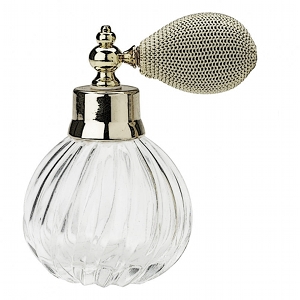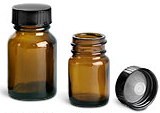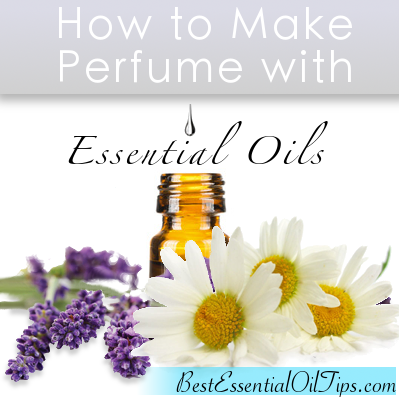 Many perfumes use synthetic ingredients in order to preserve the scent for longer periods of time. I don’t know about you but I would prefer not to smell of a particular perfume 7 days after applying it. That’s just not right! If you are like me and don’t mind applying a fragrance once per day, when desired, creating your own perfume with essential oils can be a fun alternative to those pricey, artificial concoctions. In this post, I will explain a bit of the science behind perfume making, how to make perfume with essential oils, and give some sample essential oil perfume recipes.
Many perfumes use synthetic ingredients in order to preserve the scent for longer periods of time. I don’t know about you but I would prefer not to smell of a particular perfume 7 days after applying it. That’s just not right! If you are like me and don’t mind applying a fragrance once per day, when desired, creating your own perfume with essential oils can be a fun alternative to those pricey, artificial concoctions. In this post, I will explain a bit of the science behind perfume making, how to make perfume with essential oils, and give some sample essential oil perfume recipes.
I’m not an expert in this but have dabbled a bit in making my own scents. In fact, I can be a bit of a simpleton when it comes to making “fragrances” out of essential oils. For instance, I carry around a small roll-on bottle of just 1 part lavender oil and 3 parts almond oil in my purse. The resulting smooth lavender scent lifts my spirit instantly, clears my mind, and helps me focus while alleviating any stress. However, more complex scents can be mixed up to achieve other states of emotional wellbeing. Read on, friends…
How to Make Perfume with Essential Oils
Essential oils smell great when you first open the bottle, right? As soon as you put the oil to skin the scent blossoms and envelops you, but the scent doesn’t last very long, does it? That’s where the art of perfume making steps in to create mixtures of different oils and alcohol that preserves the scents naturally and for a longer period of time. The scent of essential oil perfumes can last over a few hours on skin versus plain essential oils which may only last a few minutes to an hour.
The trick with making essential oil perfumes is to introduce each ingredient in a particular sequence. That may sound complicated but it is not at all – and I will make sure you have a decent grasp on the process in this post, don’t worry!
Here are the ingredients in the exact order you will need to follow:
- Base oil: jojoba oil, sweet almond oil, fractionated coconut oil
- Base notes: angelica, cedarwood, cinnamon, fern, frankincense, ginger, lichen, moss, patchouli, sandalwood, vanilla, valerian, vetiver oils
- Middle notes: black pepper, cassia, cardamom, chamomile, clary sage, clove, coriander, cypress, geranium, ginger, juniper, lemongrass, neroli, nutmeg, rosemary, ylang-ylang oils
- Top notes: basil, bergamot, grapefruit, jasmine, lavender, lemon, lime, mandarin, neroli, orange, orchid, peppermint, rose
- Bridge notes: lavender, vanilla oils
- Alcohol: ethanol or vodka is recommended
- Distilled water
Recipes differ on quantities and ingredients but you will always see base, middle, and top notes. Recipes may not use a base oil, bridge note, alcohol, and/or water.
Other items you will need:
 a dark glass bottle – the dark glass deters light from entering the liquid and breaking it down
a dark glass bottle – the dark glass deters light from entering the liquid and breaking it down- a funnel (optional)
- a notepad – to record the order and quantities of each ingredient you use; useful for experimenting with a particular mixture later
Advisement: your perfume(s) will need to site for at least 48 hours and up to 6 weeks without being touched and kept in a dark cool -not cold- space before usage. This is to ensure that the ingredients properly integrate and stabilize. Just trust me.
Additionally, if you make a larger batch or just anything more than you can fit into your dark glass perfume bottle, don’t worry! Put the remaining liquid into another glass container and store it in a cool, dark place. This will help to preserve your extra perfume.
Perfumery Notes – The Different Types of Scents
The fun part: selecting and mixing the different scents that will go into your perfume. I provide some recipe examples below if you are not ready to experiment. Here are some general scent types to consider. Make sure you consider which will be your base, middle, and top note(s).
- Earthy – patchouli, vetiver
- Floral – geranium, jasmine, neroli, rose, violet, ylang-ylang
- Fruity (Citrus) – bergamot, grapefruit, lemon, lemongrass, lime, mandarin, orange
- Herbal – angelica, basil, chamomile, clary sage, lavender, peppermint, rosemary
- Sea – sea salt
- Spicy – black pepper, cardamom, cinnamon, clove, coriander, ginger, juniper, nutmeg
- Woodsy – cassia, cedarwood, cypress, pine, sandalwood
Essential Oil Perfume Recipes
 Below are a few sample perfume recipes to get you going. The ingredients are listed in the order in which they should be added to the mixture. Start at the top and move down the list. Once done, put the cap on and shake your perfume gently. Place the vials in a dark place, away from any heat. Open in 48 hours, or more, and see what you think! Take notes along the way so you can modify and perfect your very own perfumes.
Below are a few sample perfume recipes to get you going. The ingredients are listed in the order in which they should be added to the mixture. Start at the top and move down the list. Once done, put the cap on and shake your perfume gently. Place the vials in a dark place, away from any heat. Open in 48 hours, or more, and see what you think! Take notes along the way so you can modify and perfect your very own perfumes.
Floral Perfume
- 10 drops valerian oil
- 10 drops chamomile oil
- 5 drops lavender oil
- 5 tablespoons vodka
- 1 cup distilled water
Grapefruit Perfume
- 1 ounce jojoba oil
- 10 drops sandalwood oil
- 10 drops lemongrass oil
- 5 drops peppermint oil
- 20 drops grapefruit oil
- 1 ounce vodka
Whispering Rain Perfume
- 5 drops sandalwood oil
- 10 drops cassia oil
- 10 drops bergamot oil
- 3 tablespoons vodka
- 1 cup distilled water
Let me know if you try any of these essential oil perfume recipes out and what you think! Also, don’t forget to create a name for your perfume and label it. Enjoy.
1 thought on “How to Make Perfume with Essential Oils”